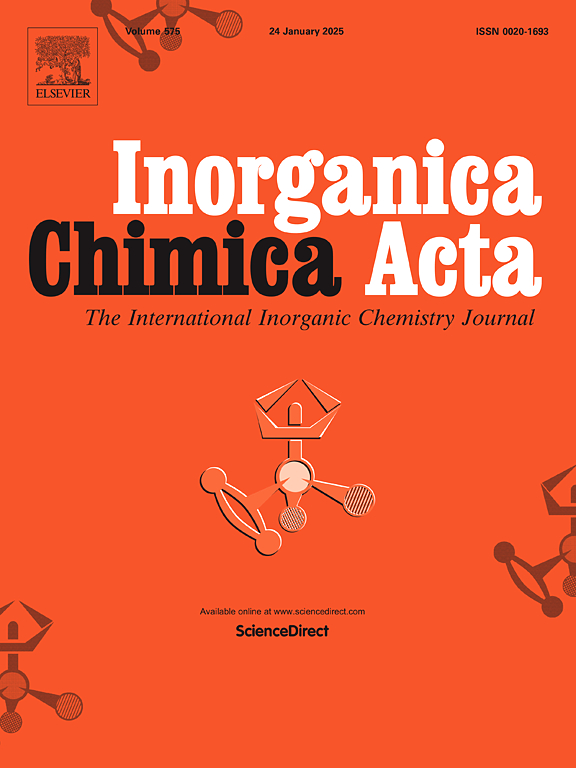Structure insights into uranium oxide hydrate materials with alkali metal ions: 2D layered structures and 3D frameworks
IF 3.2
3区 化学
Q2 CHEMISTRY, INORGANIC & NUCLEAR
引用次数: 0
Abstract
Uranium oxide hydrate (UOH) materials with alkali metals are fundamentally important. We report new structural insights into UOH materials with K+/Rb+ ions, with five compounds being synthesised and characterised, revealing both layered structures and uranium oxide hydrate frameworks (UOHFs). Compound K(H2O)2.5[(UO2)3O2(OH)3] (U-K1) crystallises in the orthorhombic Pnnm space group with a layered structure composed of α-U3O8 layers and interlayer K+ ions. Compound K3(H2O)2[(UO2)10(UO4)O8(OH)5] (U-K2) crystallises in the monoclinic C2/c space group with a framework structure composed of β-U3O8 layers pillared by double uranyl units in pentagonal bipyramids and K+ ions inside the framework channels. Although Rb(H2O)[(UO2)4O2(OH)5] (U-Rb1) crystallised in the trigonal R3 space group and Rb(H2O)2.5[(UO2)3O2(OH)3] (U-Rb2) crystallised in the orthorhombic Pnnm space group, both have layered structures with α-U3O8 type layers and interlayer Rb+ ions, differing in their U:Rb ratios: 4:1 for U-Rb1 and 3:1 for U-Rb2. Similar to U-K2, compound Rb3(H2O)2[(UO2)10(UO4)O8(OH)5] (U-Rb3) crystallises in the monoclinic C2/c space group having a framework structure with Rb+ ions inside the framework channels. This work accounts for the first report of UOHFs stabilised with exclusively alkali metal ions, highlighting the complexity of the UOH systems, with implications to uranium geochemistry and spent fuel alterations under geological disposal.

结构洞察与碱金属离子氧化铀水合物材料:二维层状结构和三维框架
含碱金属的氧化铀水合物(UOH)材料是非常重要的。我们报告了具有K+/Rb+离子的UOH材料的新结构见解,合成和表征了五种化合物,揭示了层状结构和氧化铀水合物框架(UOHFs)。化合物K(H2O)2.5[(UO2)3O2(OH)3] (U-K1)在正交Pnnm空间群中结晶,具有α-U3O8层和层间K+离子组成的层状结构。化合物K3(H2O)2[(UO2)10(UO4)O8(OH)5] (U-K2)在单斜的C2/c空间群中结晶,其框架结构由β-U3O8层组成,由五角形双基的双铀酰单元和框架通道内的K+离子组成。虽然Rb(H2O)[(UO2)4O2(OH)5] (U- rb1)在三角形R3空间群中结晶,而Rb(H2O)2.5[(UO2)3O2(OH)3] (U- rb2)在正交Pnnm空间群中结晶,但两者都是层状结构,具有α-U3O8型层和层间Rb+离子,其U:Rb比不同:U- rb1为4:1,U- rb2为3:1。与U-K2类似,化合物Rb3(H2O)2[(UO2)10(UO4)O8(OH)5] (U-Rb3)在单斜C2/c空间群中结晶,具有框架结构,框架通道内有Rb+离子。这项工作是关于纯碱金属离子稳定UOH的第一份报告,突出了UOH系统的复杂性,对铀地球化学和地质处置下的乏燃料变化具有影响。
本文章由计算机程序翻译,如有差异,请以英文原文为准。
求助全文
约1分钟内获得全文
求助全文
来源期刊

Inorganica Chimica Acta
化学-无机化学与核化学
CiteScore
6.00
自引率
3.60%
发文量
440
审稿时长
35 days
期刊介绍:
Inorganica Chimica Acta is an established international forum for all aspects of advanced Inorganic Chemistry. Original papers of high scientific level and interest are published in the form of Articles and Reviews.
Topics covered include:
• chemistry of the main group elements and the d- and f-block metals, including the synthesis, characterization and reactivity of coordination, organometallic, biomimetic, supramolecular coordination compounds, including associated computational studies;
• synthesis, physico-chemical properties, applications of molecule-based nano-scaled clusters and nanomaterials designed using the principles of coordination chemistry, as well as coordination polymers (CPs), metal-organic frameworks (MOFs), metal-organic polyhedra (MPOs);
• reaction mechanisms and physico-chemical investigations computational studies of metalloenzymes and their models;
• applications of inorganic compounds, metallodrugs and molecule-based materials.
Papers composed primarily of structural reports will typically not be considered for publication.
 求助内容:
求助内容: 应助结果提醒方式:
应助结果提醒方式:


